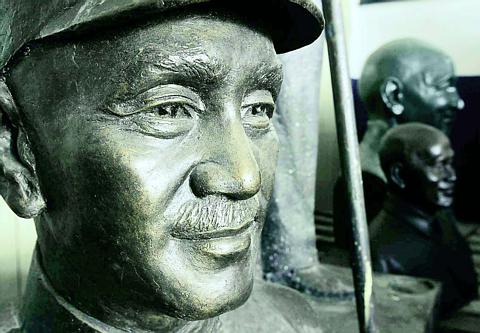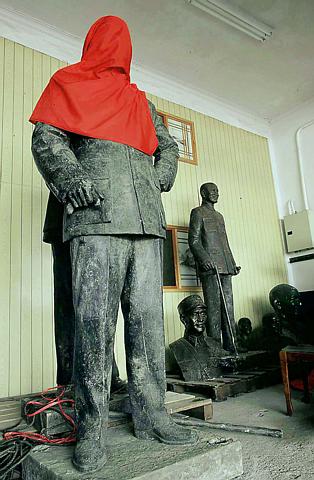Tzeng Rung-chien is a man with a mission. He's collecting the bits of Taiwan's past that nobody else wants -- Chiang Kai-shek statues.
Tzeng is mayor of Tahsi township, a small town an hour south of Taipei that attracts around 1.5 million tourists a year, most of whom come to pay their respects at Chiang Kai-shek's grave at the nearby Tsuhu Lake (慈湖).
He's a cordial man with a ready smile, and if you get a moment of his time he'll no doubt recount the story of how, last year, a visiting Russian television crew complimented him on his efforts to save recent political history from oblivion.

Photo by David Hartung
"They said, `That's what we should have done with our statues of Lenin, instead of just destroying them all,'" Tzeng said.
Tzeng has his work cut out for him. He reckons that Taiwan is home to some 43,000 statues of the former generalissimo. They're scattered around the island in schools, government buildings and parks; essentially wherever there's a public space in which people gather. For most Taiwanese today, they are anachronisms.
Chiang was president of the Republic of China on the mainland from 1926 until 1949, when his government was defeated by Mao and his indefatigable long-marchers. He ruled Taiwan with an iron hand as the president of the Republic of China in Taiwan from 1950 until his death in 1975. And for many Taiwanese his name is synonymous with all that is worst of the old-style KMT government.

The Chiang era was a time when the island's predominantly Taiwanese-speaking population received all their news and entertainment in Kuoyu, when martial law imposed travel restrictions on the local population, when all expressions of native culture and dissent were crushed by a government stacked with mainlanders claiming to govern free China.
But if Taiwan has come a long way from those "bad old days," the break with the past has been more evolutionary than revolutionary, a fact brought to life last week during protests by James Soong supporters in Taipei, many of whom were mainlanders.
So Chiang's smiling face still adorns the NT$1000 note (though there are plans to change that), and removing him from the public sphere is a sensitive process that if done too aggressively might spark off latent tensions between waishengren (mainlanders) and benshengren (native Taiwanese).
And that's where someone like Tzeng comes in.
"There are a lot of statues out there that no one wants," he says, "but people want to know that they're going to a good home. They want to know they aren't going to be destroyed."
Tzeng's "good home" is an art park, funded in part by the departments of transport and tourism and education, where he plans to display 200 of the best statues from around the island. The first of the statues, donated by the DPP Kaohsiung government, arrived at the park last month.
He says he got the idea when a dispute broke out at Taipei's Normal University between students who wanted a Chiang Kai-shek statue removed from in front of the university gates and conservative elements in the university faculty who thought it should remain.
For Tzeng, who is anxious to distance himself from any political motivations, the statues should be appreciated for their aesthetic qualities. "This is like putting a section of our history on display," he says.
"History is history, politics is politics. Some of these statues are works of art. They were created by artists."
Former journalist and now Tzeng's PR head, Wu Che-chung, agrees. "Chiang's rule is a fact," he says. "It shouldn't be a scar. We should be able to display his statues for aesthetic reasons.
"They were all hand-crafted," says Wu, as he stands in a garage attached to the local government buildings, where the 12 bronze statues that have been collected so far stand in a forlorn huddle.
"Back when Chiang ruled the country, he was like god. The craftsmen that made these statues had to be very careful to do a good job or they'd have been in deep trouble."
Wu points out how each of the statues shows Chiang at a different point in his life, in a different pose. The expression is the same in each: a tight-lipped smile, the strong chin jutting out purposefully.
"Look at this one," he says, pointing at a youthful bust. "This is Chiang back in China when he was a three-star general." And then he points to a life-size bronze that looks eerily like a terracotta warrior. "That's Chiang as President of the Republic of China here in Taiwan."
Tzeng and Wu are coy about what will happen to the thousands more Chiang Kai-shek statues around the island once their art park is complete in around two years time. But they are adamant that they shouldn't be destroyed.
"They're all works of art," says Tzeng. "We have to respect the people who created them."

June 2 to June 8 Taiwan’s woodcutters believe that if they see even one speck of red in their cooked rice, no matter how small, an accident is going to happen. Peng Chin-tian (彭錦田) swears that this has proven to be true at every stop during his decades-long career in the logging industry. Along with mining, timber harvesting was once considered the most dangerous profession in Taiwan. Not only were mishaps common during all stages of processing, it was difficult to transport the injured to get medical treatment. Many died during the arduous journey. Peng recounts some of his accidents in

“Why does Taiwan identity decline?”a group of researchers lead by University of Nevada political scientist Austin Wang (王宏恩) asked in a recent paper. After all, it is not difficult to explain the rise in Taiwanese identity after the early 1990s. But no model predicted its decline during the 2016-2018 period, they say. After testing various alternative explanations, Wang et al argue that the fall-off in Taiwanese identity during that period is related to voter hedging based on the performance of the Democratic Progressive Party (DPP). Since the DPP is perceived as the guardian of Taiwan identity, when it performs well,

The Taiwan People’s Party (TPP) on May 18 held a rally in Taichung to mark the anniversary of President William Lai’s (賴清德) inauguration on May 20. The title of the rally could be loosely translated to “May 18 recall fraudulent goods” (518退貨ㄌㄨㄚˋ!). Unlike in English, where the terms are the same, “recall” (退貨) in this context refers to product recalls due to damaged, defective or fraudulent merchandise, not the political recalls (罷免) currently dominating the headlines. I attended the rally to determine if the impression was correct that the TPP under party Chairman Huang Kuo-Chang (黃國昌) had little of a

At Computex 2025, Nvidia CEO Jensen Huang (黃仁勳) urged the government to subsidize AI. “All schools in Taiwan must integrate AI into their curricula,” he declared. A few months earlier, he said, “If I were a student today, I’d immediately start using tools like ChatGPT, Gemini Pro and Grok to learn, write and accelerate my thinking.” Huang sees the AI-bullet train leaving the station. And as one of its drivers, he’s worried about youth not getting on board — bad for their careers, and bad for his workforce. As a semiconductor supply-chain powerhouse and AI hub wannabe, Taiwan is seeing